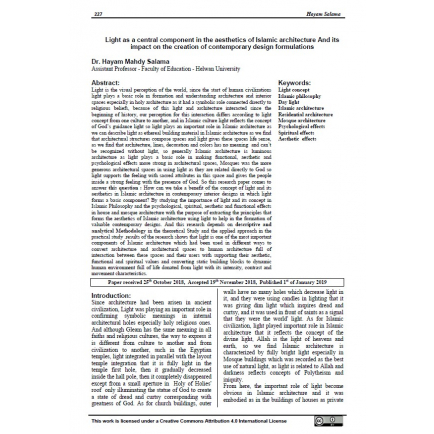
Light as a central component in the aesthetics of Islamic architecture And its impact on the creation of contemporary design formulations
تاريخ الاضافة
21/07/2022
نوع المحتوى
Article
Category
Magazine
الرابط للمحتوى
Subject Area
Mosques
الكاتب
Hayam Mahdy Salama
الناشر
International Design Journal
Year of Publication
2019
الوصف
Light is the visual perception of the world, since the start of human civilizations light plays a basic role in formation and understanding architecture and interior spaces especially in holy architecture as it had a symbolic role connected directly to religious beliefs, because of this light and architecture interacted since the beginning of history, our perception for this interaction differs according to light concept from one culture to another, and in Islamic culture light reflects the concept of God’s guidance light so light plays an important role in Islamic architecture as we can describe light as ethereal building material in Islamic architecture as we find that architectural structures compose spaces and light gives these spaces life sense, as we find that architecture, lines, decoration and colors has no meaning and can’t be recognized without light, so generally Islamic architecture is luminous architecture as light plays a basic role in making functional, aesthetic and psychological effects more strong in architectural spaces, Mosques was the more generous architectural spaces in using light as they are related directly to God so light supports the feeling with sacred attributes in this space and gives the people inside a strong feeling with the presence of God. Problem: So this research paper comes to answer this question : How can we take a benefit of the concept of light and its aesthetics in Islamic architecture in contemporary interior designsin which light forms a basic component? Objective: By studying the importance of light and its concept in Islamic Philosophy and the psychological, spiritual, aesthetic and functional effects in house and mosque architecture with the purpose of extracting the principles that forms the aesthetics of Islamic architecture using light to help in the formation of valuable contemporary designs. Methodology: this research depends on descriptive and analytical Methodology in the theoretical Study and the applied approach in the practical study . Results: results of the research shows that light is one of the most important components of Islamic architecture which had been used in different ways to convert architecture and architectural spaces to human architecture full of interaction between these spaces and their users with supporting their aesthetic, functional and spiritual values and converting static building blocks to dynamic human environment full of life donated from light with its intensity, contrast and movement characteristics.
Files





